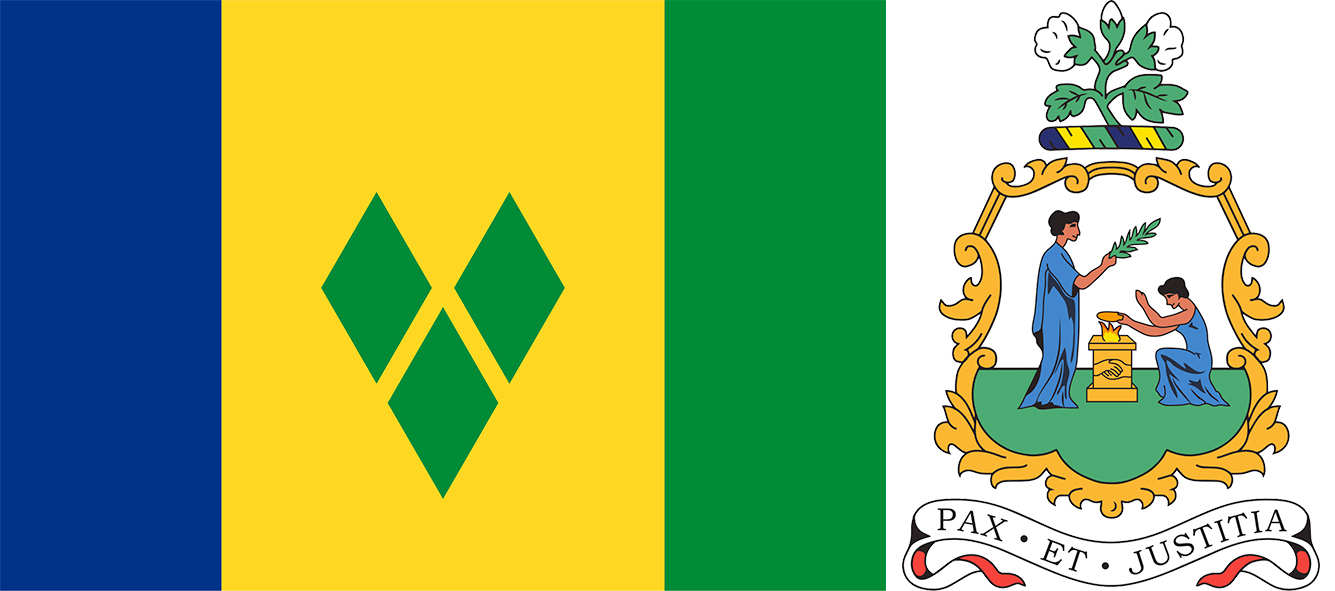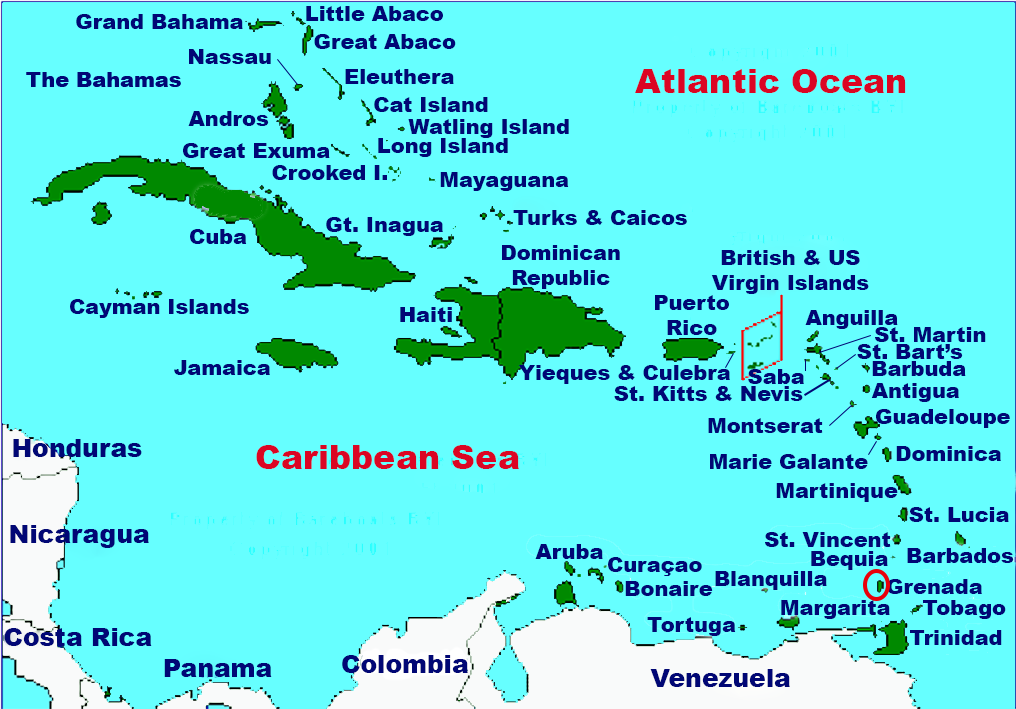FabulousFusionFood's Grenadian Recipes Home Page
 The flag of Grenada (left) and the coat of
The flag of Grenada (left) and the coat ofarms of Saint Vincent and the Grenadines (right).
Welcome to the summary page for FabulousFusionFood's Grenadian recipes, part of the Caribbean. This page provides links to all the Saint Vincent and the Grenadines recipes presented on this site, with 7 recipes in total.
This is a continuation of an entire series of pages that will, I hope, allow my visitors to better navigate this site. As well as displaying recipes by name, country and region of origin I am now planning a whole series of pages where recipes can be located by meal type and main ingredient. This page gives a listing of all the Indian recipes added to this site.
Grenada is an island country of the West Indies in the eastern Caribbean Sea and it represents the southernmost of the Windward Islands. The capital and largest city is St George's.
Grenadian cuisine is a mix of African, French and British influences with some native Carib influences. As a marjor producer of nutmeg and mace, these spices pervade the cuisine of Grenada, lending an unique quality.
Grenada (La Gwinad in Grenadian Creole French and Gwenad in Grenadian Creole English) is an island country of the West Indies in the eastern Caribbean Sea. The southernmost of the Windward Islands, Grenada is directly south of Saint Vincent and the Grenadines and about 100 miles (160 km) north of Trinidad and the South American mainland.
 Image of the Caribbean with the location ofGrenada picked out and circled in red.Grenada consists of the island of Grenada itself, two smaller islands, Carriacou and Petite Martinique, and several small islands which lie to the north of the main island and are a part of the Grenadines. Its size is 344 square kilometres, with an estimated population of 114,621 in 2024. Its capital is St. George's. Grenada is also known as the 'Island of Spice' due to its production of nutmeg and mace crops.
Image of the Caribbean with the location ofGrenada picked out and circled in red.Grenada consists of the island of Grenada itself, two smaller islands, Carriacou and Petite Martinique, and several small islands which lie to the north of the main island and are a part of the Grenadines. Its size is 344 square kilometres, with an estimated population of 114,621 in 2024. Its capital is St. George's. Grenada is also known as the 'Island of Spice' due to its production of nutmeg and mace crops.
Before the arrival of Europeans in the Americas, Grenada was inhabited by the indigenous peoples from South America. Christopher Columbus sighted Grenada in 1498 during his third voyage to the Americas. Following several unsuccessful attempts by Europeans to colonise the island due to resistance from resident Island Caribs, French settlement and colonisation began in 1649 and continued for the next century. On 10 February 1763, Grenada was ceded to the British under the Treaty of Paris. British rule continued until 1974 (except for a brief French takeover between 1779 and 1783). However, on 3 March 1967, it was granted full autonomy over its internal affairs as an Associated State, and from 1958 to 1962, Grenada was part of the Federation of the West Indies, a short-lived federation of British West Indian colonies.
Independence was granted on 7 February 1974 under the leadership of Eric Gairy, who became the first prime minister of Grenada as a sovereign state. The new country became a member of the Commonwealth of Nations, with Queen Elizabeth II as head of state. In March 1979, the Marxist–Leninist New Jewel Movement overthrew Gairy's government in a bloodless coup d'état and established the People's Revolutionary Government (PRG), headed by Maurice Bishop as prime minister. Bishop was later arrested and executed by members of the People's Revolutionary Army (PRA), which was used to justify a U.S.-led invasion in October 1983. Since then, the island has returned to a parliamentary representative democracy and has remained politically stable.
Etymoogy: The origin of the name 'Grenada' is obscure, but it is likely that Spanish sailors named the island for the city of Granada. The name 'Granada' was recorded by Spanish maps in the 1520s and referred to the islands to the north as Los Granadillos ('Little Granadas'); although those named islands were deemed the property of the King of Spain, there are no records to suggest the Spanish ever attempted to settle Grenada. The French maintained the name (as 'La Grenade' in French) after settlement and colonisation in 1649. On 10 February 1763, the island of La Grenade was ceded to the British under the Treaty of Paris. The British renamed it 'Grenada', one of many place-name anglicisations they made there.
The island was given its first European name by Christopher Columbus who sighted it on his third voyage to the region in 1498 and named it 'La Concepción' in honour of the Virgin Mary. It is said that he may have actually named it 'Assumpción', but it is uncertain, as he is said to have sighted what are now Grenada and Tobago from a distance and named them both at the same time. However, it became accepted that he named Tobago 'Assumpción' and Grenada 'La Concepción'. The year after, Italian explorer Amerigo Vespucci travelled through the region with the Spanish explorer Alonso de Ojeda and mapmaker Juan de la Cosa. Vespucci is reported to have renamed the island 'Mayo', although this is the only map where the name appears.
The indigenous Arawak who once lived on the island before the arrival of the Europeans gave the name Camajuya.
This is a continuation of an entire series of pages that will, I hope, allow my visitors to better navigate this site. As well as displaying recipes by name, country and region of origin I am now planning a whole series of pages where recipes can be located by meal type and main ingredient. This page gives a listing of all the Indian recipes added to this site.
Grenada is an island country of the West Indies in the eastern Caribbean Sea and it represents the southernmost of the Windward Islands. The capital and largest city is St George's.
Grenadian cuisine is a mix of African, French and British influences with some native Carib influences. As a marjor producer of nutmeg and mace, these spices pervade the cuisine of Grenada, lending an unique quality.
Grenada (La Gwinad in Grenadian Creole French and Gwenad in Grenadian Creole English) is an island country of the West Indies in the eastern Caribbean Sea. The southernmost of the Windward Islands, Grenada is directly south of Saint Vincent and the Grenadines and about 100 miles (160 km) north of Trinidad and the South American mainland.
 Image of the Caribbean with the location ofGrenada picked out and circled in red.
Image of the Caribbean with the location ofGrenada picked out and circled in red.Before the arrival of Europeans in the Americas, Grenada was inhabited by the indigenous peoples from South America. Christopher Columbus sighted Grenada in 1498 during his third voyage to the Americas. Following several unsuccessful attempts by Europeans to colonise the island due to resistance from resident Island Caribs, French settlement and colonisation began in 1649 and continued for the next century. On 10 February 1763, Grenada was ceded to the British under the Treaty of Paris. British rule continued until 1974 (except for a brief French takeover between 1779 and 1783). However, on 3 March 1967, it was granted full autonomy over its internal affairs as an Associated State, and from 1958 to 1962, Grenada was part of the Federation of the West Indies, a short-lived federation of British West Indian colonies.
Independence was granted on 7 February 1974 under the leadership of Eric Gairy, who became the first prime minister of Grenada as a sovereign state. The new country became a member of the Commonwealth of Nations, with Queen Elizabeth II as head of state. In March 1979, the Marxist–Leninist New Jewel Movement overthrew Gairy's government in a bloodless coup d'état and established the People's Revolutionary Government (PRG), headed by Maurice Bishop as prime minister. Bishop was later arrested and executed by members of the People's Revolutionary Army (PRA), which was used to justify a U.S.-led invasion in October 1983. Since then, the island has returned to a parliamentary representative democracy and has remained politically stable.
Etymoogy: The origin of the name 'Grenada' is obscure, but it is likely that Spanish sailors named the island for the city of Granada. The name 'Granada' was recorded by Spanish maps in the 1520s and referred to the islands to the north as Los Granadillos ('Little Granadas'); although those named islands were deemed the property of the King of Spain, there are no records to suggest the Spanish ever attempted to settle Grenada. The French maintained the name (as 'La Grenade' in French) after settlement and colonisation in 1649. On 10 February 1763, the island of La Grenade was ceded to the British under the Treaty of Paris. The British renamed it 'Grenada', one of many place-name anglicisations they made there.
The island was given its first European name by Christopher Columbus who sighted it on his third voyage to the region in 1498 and named it 'La Concepción' in honour of the Virgin Mary. It is said that he may have actually named it 'Assumpción', but it is uncertain, as he is said to have sighted what are now Grenada and Tobago from a distance and named them both at the same time. However, it became accepted that he named Tobago 'Assumpción' and Grenada 'La Concepción'. The year after, Italian explorer Amerigo Vespucci travelled through the region with the Spanish explorer Alonso de Ojeda and mapmaker Juan de la Cosa. Vespucci is reported to have renamed the island 'Mayo', although this is the only map where the name appears.
The indigenous Arawak who once lived on the island before the arrival of the Europeans gave the name Camajuya.
Grenadian Cuisine:
The national dish, oil down, is a combination of breadfruit, coconut milk, turmeric (misnamed saffron), dumplings, callaloo (taro leaves), and salted meat such as saltfish (sat cod), smoked herring or salt beef. It is often cooked in a large pot, commonly referred to by locals as a karhee, or curry pot. Popular street foods include aloo pie, doubles, and dal puri served wrapped around a curry, commonly goat, and fried bakes and fish cakes. Sweets include kurma, guava cheese, fudge or barfi, tamarind balls, rum-raisin ice cream, currant rolls, and Grenadian spice cake. Nutmeg and mace (spice) are used in abundance.The alphabetical list of all the Grenadian recipes on this site follows, (limited to 100 recipes per page). There are 7 recipes in total:
Page 1 of 1
| Grenada Curry Goat Origin: Grenada | Grenada Oil Down Origin: Grenada | Grenadian Pelau Origin: Grenada |
| Grenada Curry Powder Origin: Grenada | Grenada Rice and Peas Origin: Grenada | |
| Grenada Green Seasoning Origin: Grenada | Grenadan Dumplings Origin: Grenada |
Page 1 of 1